Parents need choices for child care. Across the state, parents face a shortage of quality child care options, which has been made worse by the pandemic. Increasing the subsidy rates to the most recent statewide average rates can help child care centers stay open, or reopen, to serve more children & families who need care to go to work.
Setting Smarter Rates
North Carolina’s child care subsidy program helps cover some of the costs of licensed early childhood education for more than 60,000 children each year.
Child care providers in North Carolina are reimbursed for child care subsidy according to rates set by the NC General Assembly. The subsidy rates are based on county-specific market rates, which are determined from a statewide survey of private fee-paying rates for child care. Subsidy rates vary by county, the age of children served, and other factors. Current rates are still based on 2018 data, even though the most recent child care market rate survey was conducted in 2021.
Using different rates for each county creates major geographic inequities. Many child care providers in low-income and rural counties receive thousands of dollars less per month than in urban counties – despite providing equivalent high-quality early learning experiences. As a result, child care programs are not financially viable, and there are not enough programs to meet the community need.
Increasing the subsidy rates and creating a new statewide floor helps families in every county access quality child care close to home, while supporting local businesses.
Supporting the Workforce Behind the Workforce
Low subsidy rates are a long-standing problem. Most child care providers are small businesses operating at razor-thin margins. The pay for teaching staff is extremely low, and benefits are scarce. The average wage of a child care teacher in North Carolina is just $12/hour, despite the fact they have one of the most important jobs in our state.
An increased subsidy rate would allow providers to improve quality and availability for families. These could include increasing teacher pay & benefits, professional development, and more.
Child Care is Vital for Working Families
Families can’t work without child care. However, the COVID-19 pandemic put major pressure on our already-fragile child care system. Providers are n facing reduced revenues and labor shortages as ongoing results of the pandemic.
One-time relief funding has been vital to keeping child care providers open during the worst of the pandemic. However, without significant long-term funding changes, it will be extremely difficult to build back a sustainable child care system that can actually meet families’ needs – especially in rural counties where child care programs are scarce.2
Increasing the subsidy rates to the most recent rates and raising the floor on the rates to the statewide average helps shore up the system and move toward greater sustainability over time.
Raising subsidy rates has several very important components:
- Hold harmless providers in counties where the subsidy reimbursement rate is already at or above the new rates and statewide floor, to avoid damaging cuts. Counties where subsidy rates are already higher than the statewide average will still receive their county rates.
- Eliminate the restriction that child care programs cannot receive subsidy rates higher than their private-pay rate. This would protect parents who do not receive subsidy from being subject to higher rates – rates that are already unaffordable.
Updating the subsidy rates is a necessary interim step. North Carolina needs to develop a better method for calculating subsidy rates that reflects the true cost of high-quality child care. NC DHHS is planning to pursue an alternative methodology that will better align subsidy rates with the true cost of care. However, child care is essential to North Carolina’s workforce – current and future – and this interim step to increase rates will help these vital small businesses stay open.
Endnotes
1 Gregory, C., O’Neal, R., & Brannon, Y. (2022). North Carolina Child Care Market Rate Study 2021. Center for Urban Affairs & Community Services. North Carolina State University.
2 Workman, S. & Hamm, K. (2020). 6 state strategies to improve child care policies during the pandemic and beyond. Center for American Progress.

